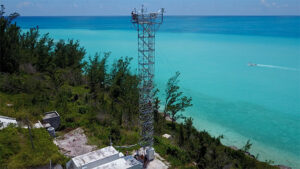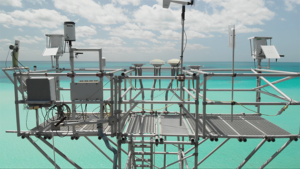A BIOS Treasure: The Tudor Hill Marine Atmospheric Observatory

The BIOS-run Tudor Hill Marine Atmospheric Observatory recently supported international collaborations resulting in two publications in the scientific journals Atmospheric Chemistry and Physics and the Journal of Geophysical Research: Atmospheres. The papers, both authored by researchers from the University of Arizona, focus on the characterization of aerosol interactions in the atmosphere in support of NASA’s Aerosol Cloud meTerology Interactions oVer the western ATlantic Experiment (ACTIVATE). Aerosols are particulate organic matter from natural origins, such as volcanoes or sea salt, or human-made sources, such as the combustion of fossil fuel. Despite their small size, aerosols can have a major impact on global climate.
Perched near the shoreline on the southwest coast of Bermuda, the Tudor Hill Marine Atmospheric Observatory is one of BIOS’s lesser-known gems, and the source for data used in two scientific papers published last year in leading scientific journals. The publications – Atmospheric Chemistry and Physics and the Journal of Geophysical Research: Atmospheres – feature collaborations among multiple researchers in the U.S., Germany, and Bermuda, including BIOS environmental chemist and Tudor Hill observatory lead scientist Andrew Peters.
The observatory, supported by the National Science Foundation, collects data year-round on the chemical and physical properties of the atmosphere, similar to how the Bermuda Atlantic Time-series Study program, Hydrostation ‘S,’ and the Oceanic Flux Program provide researchers with decades-long sets of data on ocean properties. Routine sampling activities at the facility include basic meteorological data, such as wind speed, air temperature, and humidity, as well as carbon dioxide and other greenhouse gases, ozone concentrations, and persistent organic pollutants, such as DDT, PCB, and other industrial chemicals.
Sampling also includes aerosols, particulate matter derived from natural origins, such as volcanoes, sea salt, or sandstorms, or human-made sources, such as fossil fuel combustion and deforestation.

The 75-foot-tall (23 meter) tower at Tudor Hill supports a variety of scientific sampling equipment. Routine sampling activities at the facility include basic meteorological data, such as wind speed, air temperature, and humidity, as well as carbon dioxide and other greenhouse gases, ozone concentrations, and persistent organic pollutants, such as DDT, PCB, and other industrial chemicals. Sampling also includes aerosols.
“The island of Bermuda has historically been a critically important location for atmospheric research since it serves as an excellent ‘marine laboratory’ with long-term data sets collected at surface measurement sites,” said Armin Sorooshian, a chemical and environmental engineer at the University of Arizona and principal investigator on both projects. “Its location helps with studies of transported gas and particle emissions from distant continents.”
Many of these activities are conducted as part of international programs, like the NASA AErosol RObotic NETwork (AERONET), that are designed to provide scientists with the information required to understand global-scale questions. Other activities include investigations into topics such as the impact of pollution on the distribution of ozone in the global troposphere (the lowest layer of the atmosphere), and the role that aerosol particles play in the flux of nutrients between the atmosphere and the surface ocean.
Data from these programs are also useful in improving models of climate variability and projections of climate change.
The two publications, both authored by researchers from the Department of Chemical and Environmental Engineering at the University of Arizona, focus on the characterization of aerosol interactions in the atmosphere in support of NASA’s Aerosol Cloud meTeorology Interactions oVer the western ATlantic Experiment (ACTIVATE). Aerosols are a particularly timely and relevant field of study, as they can have a major impact on global climate once they make their way skyward. They can scatter or absorb light, cooling or warming Earth’s atmosphere. The deposition of aerosols, such as black carbon, in the Arctic is changing the reflectivity of ice and causing it to melt faster. Finally, aerosols act as “seeds” that promote the formation of dense, reflective, bright clouds that shade the planet’s surface.
Postdoctoral research associate Hossein Dadashazar led a team of 16 researchers investigating the impact of precipitation on aerosol particles traveling in air masses from the East Coast of the U.S. to Bermuda. The group utilized aerosol data from the AERONET surface station at the observatory as part of its study, as well as additional aerosol and gas data from the BIOS-run Bermuda Air Quality Program monitoring station at Fort Prospect.
The results, published in November 2021 in the journal Atmospheric Chemistry and Physics, highlight the important role of precipitation in modifying aerosol levels along predominant air pathways reaching Bermuda. Specifically, they found a significant reduction in aerosol concentration during transport from the U.S. to Bermuda when the air masses encountered clouds and precipitation.
Earlier in 2021, graduate research assistant Abdulmonam Aldhaif authored a paper published in the Journal of Geophysical Research: Atmospheres. The investigation, which involved five additional scientists, used multiple years of data from various sources and models to create an “aerosol climatology” for Bermuda, or a case study of how aerosols change throughout the year with varying conditions, such as weather and atmospheric circulation.
As with the previous paper, this study also utilized data from the AERONET station at the Tudor Hill observatory, noting that it is “one of the longest records of data…capable of providing monthly statistics of aerosol properties.” Findings by Aldhaif and colleagues include that African dust routinely reaches Bermuda, particularly during the summer months; that sea salt is a major source of “seeds” for cloud formation; and that aerosol emissions from North America can reach the atmosphere over the island.
“It’s rare to find an island laboratory with such rare, high-quality data that can be used to address some of the most pressing questions in ocean-atmospheric research,” Sorooshian said. “And working with Andrew Peters has made the international collaboration seamless and fruitful.”
